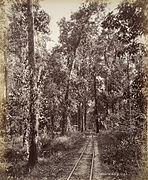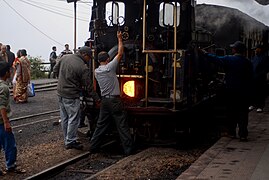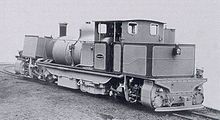History Of Darjeeling Himalayan Railway
On 5 December 1999, UNESCO declared the DHR a World Heritage Site. Two more railway lines were later added, and the site became known as one of the mountain railways of India.
History
Siliguri, at the base of the Himalayas, was connected with Calcutta (now Kolkata) by a metre gauge railway in 1878. Between Siliguri and Darjeeling, Tonga services ran on a cart road – the present-day Hill Cart Road. Franklin Prestage, an agent of the Eastern Bengal Railway, approached the government with a proposal to lay a steam tramway from Siliguri to Darjeeling. Ashley Eden, lieutenant governor of Bengal, formed a committee to assess the project's feasibility. The proposal was accepted in 1879 after a positive report by the committee, and construction began that year.
Gillanders, Arbuthnot and Company was hired to construct the line and, by March 1880, track was laid as far as Tindharia, and Lord Lytton, the first viceroy to visit Darjeeling, rode to Tindharia on the train. Colonel F.S. Taylor, R.E., Consulting Engineer to the Government of India for Guaranteed Railways, and Franklin Prestage inspected the line and authorised the stretch from Siliguri to Kurseong open for traffic from 16 August 1880. It opened a few days later on 23 August 1880. The stretch from Siliguri to Darjeeling opened on 4 July 1881. The company's name was changed to Darjeeling Himalayan Railway Company.
Although the railway originally followed Hill Cart Road, the steepness of the road was more than the locomotives could handle in some areas. In 1882, four loops and four zig-zags were built between Sukna and Gayabari to ease the gradient to a uniform 1 in 28. The line was extended by a quarter-mile to Darjeeling Bazar in 1886. The Darjeeling station was renovated in 1891 and Kurseong got a new station building and storage shed in 1896, but the railway was affected by an 1897 earthquake and a major cyclone in 1899. In 1902, heavy rains caused many landslips along the route and the Teesta bridge was washed away. Services were maintained with transhipments at the breaks.
In 1910, the DHR carried 174,000 passengers and 47,000 tons of goods. The first bogie carriages entered service, replacing basic four-wheel carriages. DHR extension lines were built to Kishanganj in 1914 and Gielkhola in 1915. At Tindharia, the railway works were relocated from behind the locomotive shed to a larger site.
The Batasia Loop was constructed in 1919, creating easier gradients on the ascent from Darjeeling. The DHR began facing competition from buses operating on the Hill Cart Road which took less time than the railway to reach Darjeeling. In 1934, a major earthquake in Bihar shook all of Northeast India. Many buildings in Darjeeling were heavily damaged and the railway was also affected, although it soon recovered and played a vital role in transporting repair materials. During World War II, the DHR transported military personnel and supplies to the camps around Ghum and Darjeeling.
In 1951, the railway was purchased by the Indian government and absorbed into the government railway organisation before it was managed by the Assam Railway. Assam Railway (including the DHR) became part of the North Eastern Railway zone in 1952, and part of Indian Railways' Northeast Frontier Railway zone six years later. In 1962, the railway was realigned at Siliguri and extended by nearly 6 km (3.7 mi) to New Jalpaiguri (NJP) to meet the new broad-gauge line there. The extension began freight service that year, and passenger service in 1964. The locomotive shed and carriage depot at Siliguri Junction were moved to NJP.
The railway was closed for 18 months during the Gorkhaland hostilities in 1988 and 1989. It was declared a World Heritage Site by UNESCO in 1999.
Following the COVID-19 pandemic in the country, the service was stopped for 18 months from March 2020 to August 2021. On 25 August 2021, the service was restarted from New Jalpaiguri to Darjeeling with the new vistadome coaches for the tourists.
-
1880 line through the Terai
-
The railway in 1895
-
The Choonbatty loop in 1895
-
Darjeeling reversing station around 1905
-
The Agony Point loop in 1921
-
1930s train
-
Locomove in shed, 1979
Operators

The DHR and its assets, including the stations, line and vehicles, is owned by the government of India and entrusted to the Ministry of Railways. The Northeast Frontier Railway documented the railway in a comprehensive register, and handles its day-to-day maintenance and management. Several programs, divisions and departments of Indian Railways are responsible for operating, maintaining and repairing the DHR. It is protected by the 1989 Railway Act and the stipulations governing public property. It is now headed by the director, Darjeeling Himalayan Railway.
Rolling stock
Present
Steam
All the steam locomotives currently in use on the railway are 0-4-0ST B-Class, built by Sharp, Stewart and Company and later the North British Locomotive Company between 1889 and 1925. A total of 34 were built but, by 2005, only 12 were still in use or being repaired by the railway.
In 2002, No. 787 was rebuilt for oil firing on the same principle as that used on Nilgiri Mountain Railway No. 37395. A diesel-powered generator was fitted to operate the oil burner and an electrically driven feed pump, and a diesel-powered compressor was fitted to power the braking system. The locomotive was also fitted with a feedwater heater. The rebuild dramatically changed its appearance. Trials of the refitted locomotive were disappointing, and it never entered regular service; in early 2011, it was in the Tindharia Works awaiting re-conversion to coal-firing. In early 2019, B787 was restored cosmetically and is now displayed on a plinth outside Siliguri Junction station.
In March 2001, No. 794 was transferred to the Matheran Hill Railway for a "joy train" (a steam-hauled tourist train) on that railway. It entered service there in May 2002.
-
First construction locomotive called 'Baby Sivok'
-
B-Class locomotive
-
Loading coal into a locomotive
-
Daily maintenance
























